Kia Ora (Hello)!
You’re probably here because you have decided to visit New Zealand. That is so exciting! I remember the days when we were planning—we read so many blogs! It still took us nearly a month and a half to get things sorted. Despite all that research, I would say we were not fully equipped with all the details while planning, as we didn’t find a good enough New Zealand trip planner. We learned a lot during our time there that we wish we could have known before. The article below is aimed at helping you plan the perfect New Zealand trip by providing details of what we learned! I have tried to include everything or given links to more information. Read on and enjoy learning Maori words and NZ slang mentioned in italics throughout the article. It’s going to be fun, eh?
Table of Contents
- A little about New Zealand or Aotearoa “The Land of the Long White Cloud”
- Seasons: When to visit New Zealand?
- Duration: How long should the New Zealand Trip be?
- Mode of Transport: How should I travel within New Zealand?
- Planning: How to plan a New Zealand Road Trip?
- Budgeting: How much would a New Zealand vacation cost?
- Packing Essentials: What to pack for a New Zealand trip?
- Resources: What are the helpful apps and websites I may need?
- Other must knows while planning a New Zealand Trip
A little about New Zealand or Aotearoa
“The Land of the Long White Cloud”
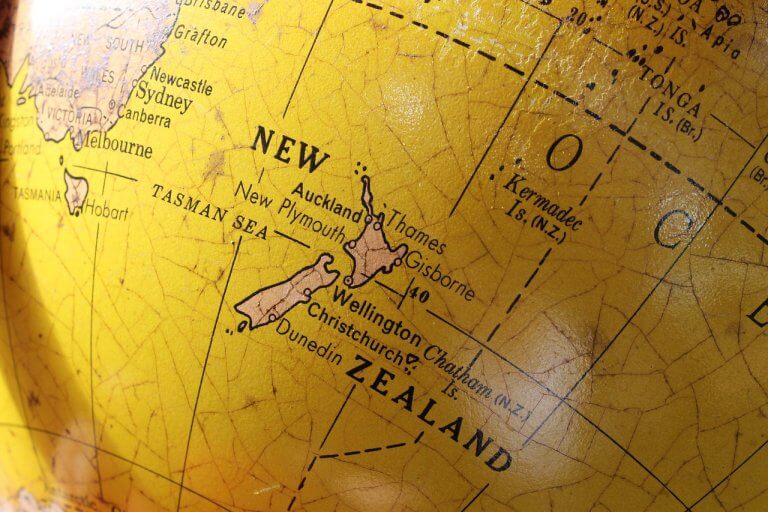
- New Zealand is in the Oceania region, more than 4000 km southeast of Australia, its nearest neighbour.
- The country has two main landmasses—the North Island and the South Island—and a large number of smaller surrounding islands.
- New Zealand is 1600 km long from top to bottom which takes about 30 hours to drive non-stop. No place in New Zealand is more than 120 km from the coast.
- New Zealand’s capital city is Wellington, the southernmost capital city in the world.
- Only 5% of New Zealand’s population is human- the rest are animals. Hello, hordes of sheep!
- Owing to its remote location, this country was the last large habitable landmass to be occupied by humans. Polynesians settled here between 1250-1300 and developed a unique Maori culture. Today only about 15% of the country’s population is Maori. The majority are of European descent.
- The official languages are English and Maori. English is spoken by over 95% of the population.
- New Zealand is the first country to greet a new day.
- New Zealand follows the metric system- litre, gram, metre, Celsius.
- The currency is NZD (New Zealand Dollar): 1 USD= 1.63 NZD (approx.). Click for the current rate.
Seasons: When to visit New Zealand?
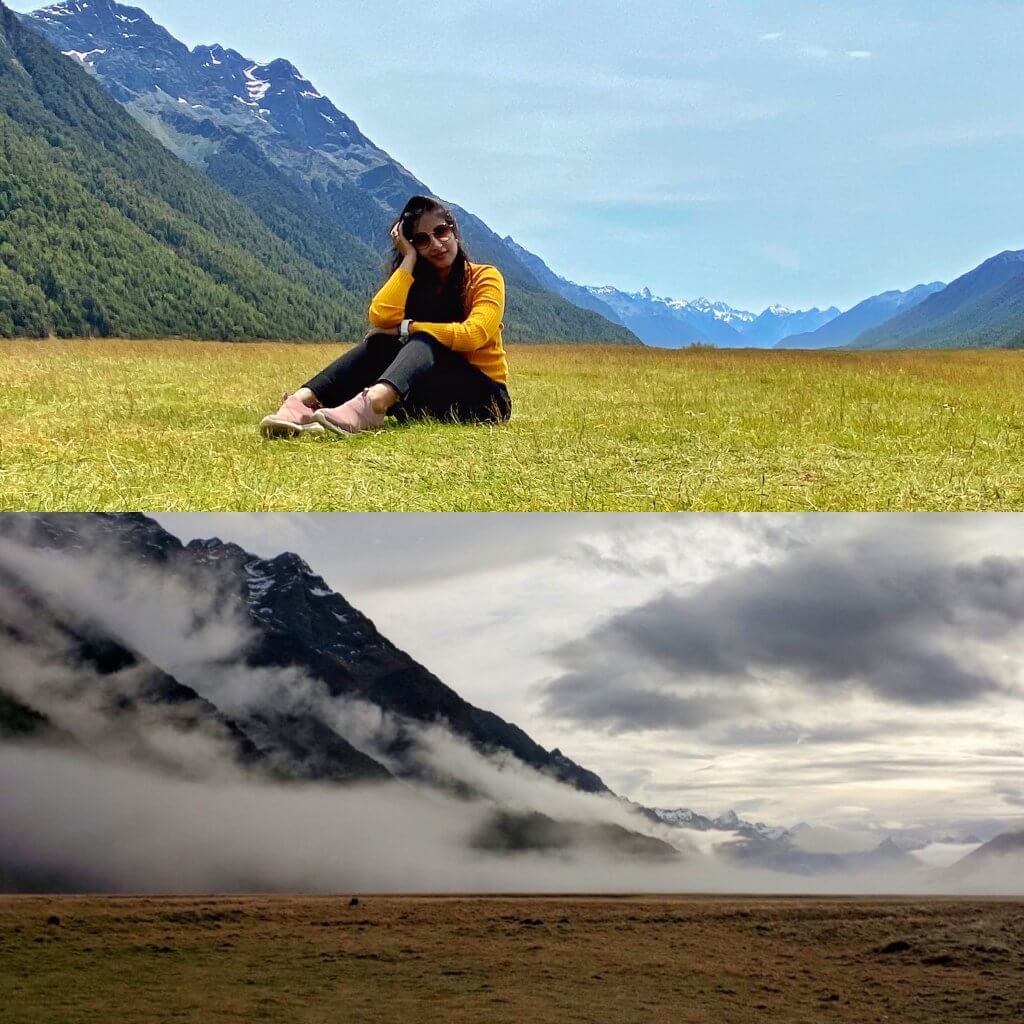
Summer: December-February
Since Aotearoa (New Zealand) is in the southern hemisphere, summer is December through February, making it a popular place to visit at this time of the year. Daytime temperatures vary approximately between 20 and 30 °C. Days are long with about 15 hours of sunshine; the sun rises at 5:40 am and sets at 8:51 pm (December data for Wellington). (Click here for updated timings.). The average temperature decreases as you travel south. As this is the peak season for tourists, travel is exorbitantly expensive. The best time for a New Zealand trip in the summer is late February, when the locals have resumed their routine lives after the January vacation and the sunshine is at its best.
Autumn: March-May
These are shoulder months for travelling to New Zealand: summer crowds have dispersed, winter is not here yet, and the trees are beautiful shades of yellow and orange. Daytime temperatures vary approximately between 17 and 21 °C. Planning a trip in autumn would be very light on your pocket as the prices drop significantly and the weather is the most favourable for tramping (hiking).
I would say March and April would be the best months to visit in the whole year. Though May would be the real money-saver!
Winter: June-August
Days are short, and the daytime temperature varies between 10 and 16 °C, approximately. Alpine landscapes come to life with spectacular ski fields. While the mountains are covered in snow, the lowlands don’t usually experience the same. Also, winter is relatively mild in the lowlands due to their proximity to the ocean. Matariki, the Maori New Year, is celebrated in the winter, so you can enjoy the cultural festivities. New Zealand also hosts several fun winter festivals against the backdrop of impressive snow-covered hills. However, many activities, like glacier walks and rafting, may be cancelled depending on the conditions. July is New Zealand’s coldest month.
Spring: September-November
Again, shoulder months, but relatively volatile weather. Daytime temperatures vary between 16 to 19ºC approximately. You can witness snow till early September in the mountains, while the lowlands slowly start blooming with flowers. November would be the best month for a spring vacation as the climate is inching towards summer, days are longer, New Zealand is bright and colourful with flowers, and the crowds haven’t arrived yet.
There is something different to see in every season in New Zealand, no matter the month. Making it a great place to visit all year round, depending on your likes and dislikes.
Duration: How long should the New Zealand Trip be?
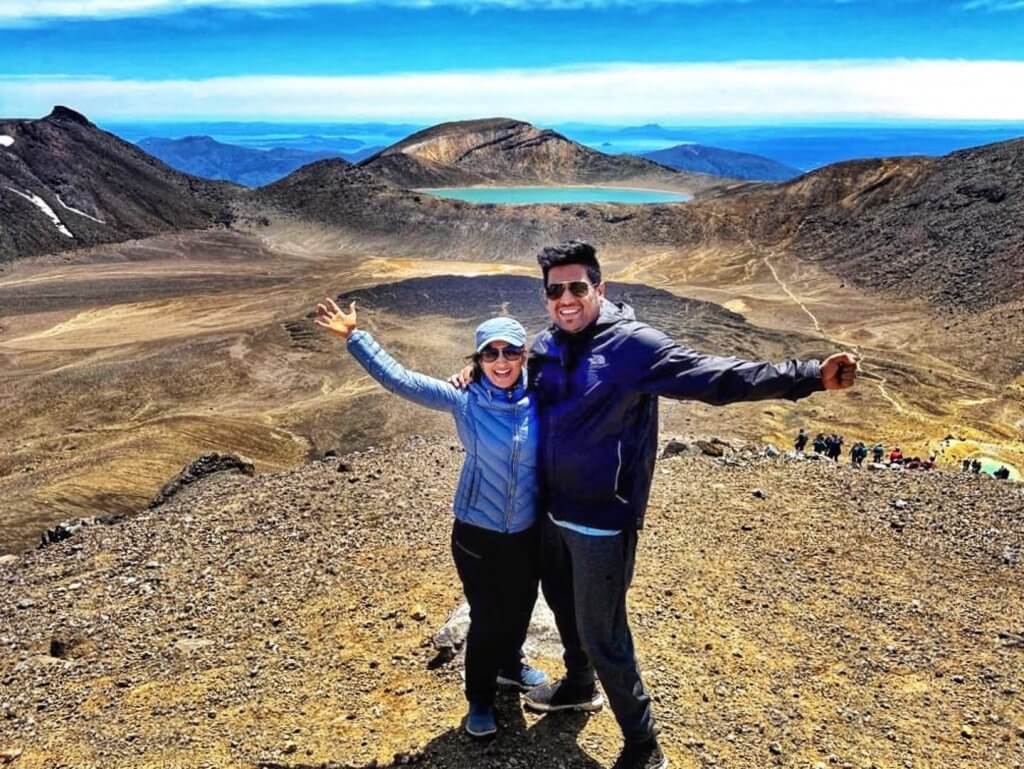
New Zealand is a very remote country, except if you’re from Australia. Therefore, it makes sense to visit for at least two weeks. Though three to four weeks would be ideal to cover all major places at a more relaxed pace.
We did an 18-day, fast-paced New Zealand road trip, and thought that we needed at least a week more. Read about our trip of a lifetime here.
You could take a side trip to Fiji as well if you have more time. But do not compromise on one country for another!
Mode of Transport: How should I travel within New Zealand?
New Zealand has buses, trains, flights, ferries, and everything in between. If you’re on a really tight budget or travelling solo, then try the hop-on, hop-off buses. Kiwi Experience, Intercity, and Stray are quite famous. Click on the respective links to read about how they work.
That said, the best way to see the country is by road, with the luxury of stopping wherever you want and going wherever you wish. Trust me, you will want to stop time and again to take in the beautiful vistas. I would suggest renting a car or campervan, as they are the most convenient and also the most popular form of transport in Aotearoa (New Zealand).
Points to note for vehicle hire:
- You don’t need an international driving licence. Your home country driving licence will do just fine if it is in the English language. If it isn’t, then you will have to get it converted by your country’s embassy or by a New Zealand Transport Agency.
- New Zealand has a left-side drive. So be prepared for that if you’re from a country that has right-side driving!
- The standard speed limit in New Zealand is 100 km/hr. The speed limit is lowered depending on the area (city, town, construction area, etc.) and even goes down to 15 km/hr in some places. Follow the road signs and avoid over-speeding. We thought we did alright, but we got a ticket and were only informed about it after 15-20 days of leaving the country. We still don’t know when or how that happened!
- Before going on vacation, do watch this video on New Zealand driving rules.
- It is illegal to hold your phone while driving.
- New Zealand roads are in perfect condition, so it is a breeze to drive there. Also, there are road signs for just about everything, so you will always know what lies ahead.
Should I hire a car or a campervan for a New Zealand road trip?
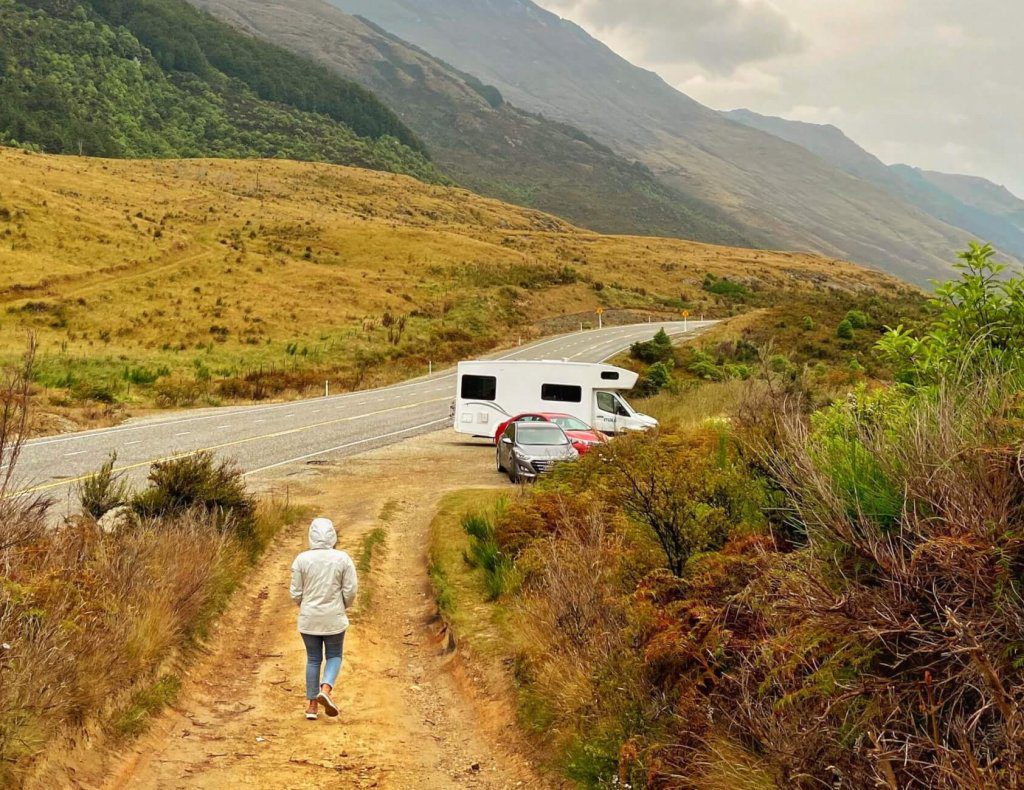
Your decision to go for a campervan or car rental in New Zealand would be based on the following:
1. Are you willing to live in confined spaces?
If you are then hiring a campervan is the way to go, else stick to a car!
2. Are you comfortable driving a big vehicle?
New Zealand’s numerous single-lane curvy roads and strong winds can really put your driving skills to a test. The bigger the vehicle the tougher it gets to handle. Try a smaller camper-car or go for a car if you won’t be comfortable driving a big vehicle.
3. Are you deciding on renting a campervan to save money?
Do the price comparison before you assume that campervans are cheaper. Remember bigger vehicles cost more to rent, are less-fuel efficient, and you have to pay per person for using holiday parks and camping sites. You will save significantly if you take a small camper car and are willing to stay at free campsites on most days, however, these will have very limited facilities. To read about the difference between holiday parks and campsites, click here.
4. Are you deciding on renting a campervan so you can camp/park anywhere?
Freedom camping is allowed only if your campervan is certified self-contained (Has a toilet, can store at least three days worth of freshwater and wastewater, and displays a blue sticker indicating self-containment). If you hire a self-contained vehicle you can park anywhere, except in no camping zones. If this interests you, read more on freedom camping here.
We decided to hire a car as both of us were not comfortable driving a big vehicle; our itinerary was fast-paced and we did not want to slow down because of our vehicle; also, we were on our honeymoon, so being holed up in a campervan was a non-starter. However, while travelling around the country, we noticed that there were some holiday parks at amazing locations- next to the lake/beach, in secluded spots, under the mountains. If we did the trip again, we would probably hire a campervan in North Island (reason: less twisty exposed roads) and hire a car in South Island (reason: more days on the road) to get the best of both worlds.
What factors should I consider while choosing a rental car in New Zealand?
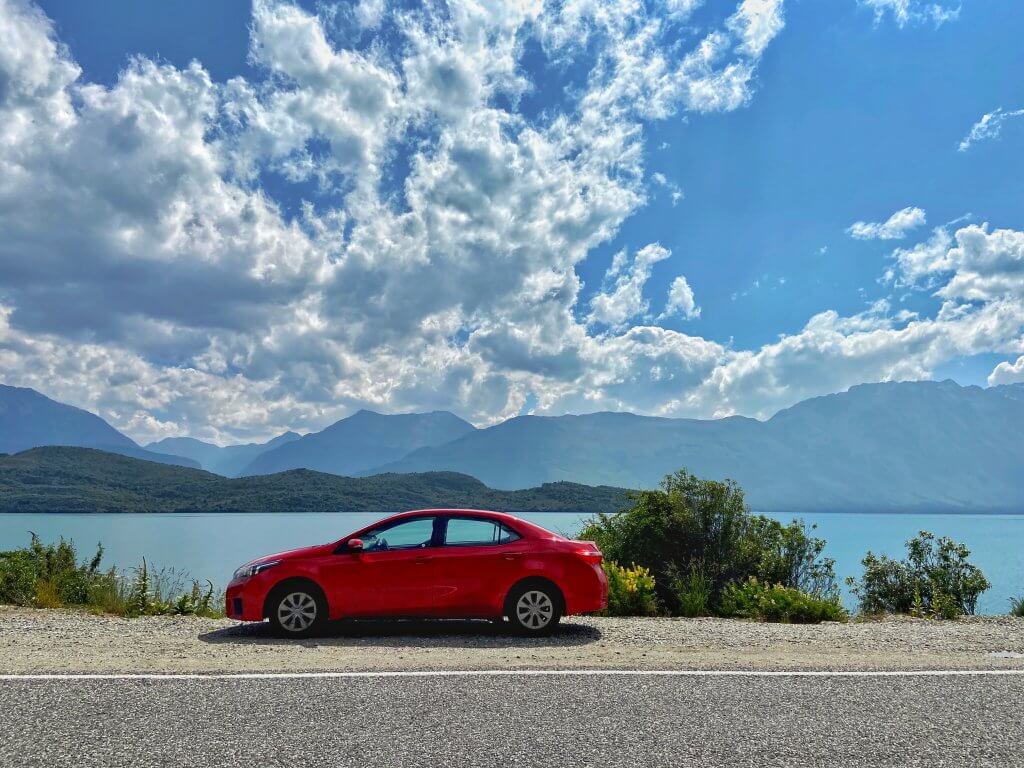
While looking for a car/car rental company in New Zealand do check the following:
- Vehicle model and year of manufacture– Older vehicles mean significantly lesser rent. However, they are characterized by an increase in the risk of breakdown and are less fuel-efficient.
- Size of Vehicle– Bigger the vehicle, higher the rent.
- Pick up location– Check if picking up your car at the airport attracts higher charges.
- Pick up and drop location– Check if you are being charged a one-way fee if you pick your vehicle at one location and drop off at the other.
- Ferry Cost– If you are taking your car on the ferry between Wellington (North Island) and Picton (South Island), you will again be charged extra. Check if the car rental company has offices in Wellington and Picton so you can drop off your car and hire a new one at the next island to avoid these extra charges.
- Insurance– While New Zealand is a safe country, do take insurance to cover accidents or damage to your vehicle.
- Insurance is charged on a per-day basis
- Some companies have insurance caps that are helpful if you are renting the vehicle for a really long period.
- Read the insurance terms and conditions carefully before booking the car.
- Preferably opt for an insurance plan with zero excess. Better to be safe than sorry! (‘Excess’ implies the maximum amount you will be liable for on claiming insurance.)
- Extra Driver Cost– If more than one person is to drive the car then you may be charged an extra driver fee which may be per day or at a flat rate.
- Age Factor– Drivers under 21 attract higher insurance and young drivers fees in most rental companies.
- 24-Hour Roadside Assistance– Check if your rental company provides 24-Hour Roadside assistance as it could be helpful to handle the jandal (handle the situation) in times of trouble. Also, read their policy with regards to the same.
- Unlimited Mileage– Check if your rental company provides unlimited kilometres.
- Security Deposit– Check if your rental company requires you to pay a security deposit.
- Extras- Extras like GPS, Snow Chains, Wi-fi Hotspot, Picnic Table & Chairs, Plug come at an extra cost. If it is turning out to be a lot of money for extras you need, you can consider purchasing them from department stores. The Warehouse is a fantastic store for purchasing such items.
Also, no need to take a GPS. Google Maps works just fine. To avoid getting stuck in the wop wops (middle of nowhere) due to inconsistent internet connectivity, keep maps for the entire country (or areas you are travelling through) downloaded. We do this for every road trip we take and we have never faced any issues. - Reviews– Read reviews of the car rental company to know the worst experiences people have had and see the ratio of bad to total reviews.
We hired a car from Omega Car Rentals and we had no trouble throughout the New Zealand road trip. We opted for Omega as they provide a free one-way hire and free additional driver, have shuttle services between the airport/ferry terminal and their office, had an option to pick another car in Picton as opposed to taking the car on the ferry, and obviously, prices were the cheapest we found at the time.
Planning: How to plan a New Zealand Road Trip?
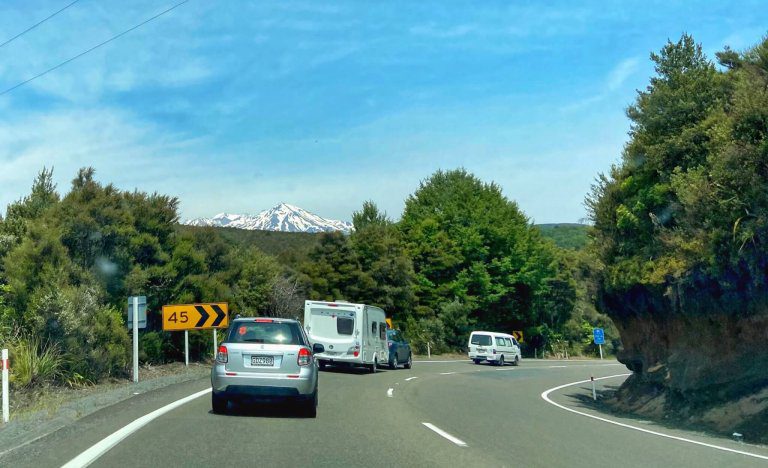
I am sure a lot of you would want to just wing it and not have a plan for your trip. That is perfect for a New Zealand trip during the offseason. But do not attempt this in the summer months.
During the summer months, everything gets sold out- the best accommodations, cars and campervans, and the sought after activities. Only the most expensive and inconvenient options are left. We started booking accommodations early September for a mid-December trip and we were left with very few and expensive options in a couple of towns. So make your reservations at least four months prior if not even earlier.
Process:
- Read up and figure out the places you want to visit.
- List down the activities you want to do in these places, how much time they will take and how many days would be required to do them. Check out our list of must sees and dos that you just cannot skip on New Zealand trip.
- Now on google maps mark the shortlisted places and see routes and distances. Note: I would say do not drive for more than 4-5 hours a day per google maps time unless it is really necessary. New Zealand roads are different compared to the ones you may have driven on before. You will want to drive slowly on curvy roads, stop time and again to take photos, hop-off at lookout points/midway attractions, or just relax/picnic. 4-5 hours may turn to 5-7 hours or more.
- Make a day-wise itinerary.
- Now you can apply for a visa (if required). Check visa requirements here.
- Accordingly, book your car/campervan and flights. If you have a flexible schedule, do play around with the dates to get the best deal.
- Book accommodations (if not hiring a campervan)
- Book activities that sell out fast- Hobbiton, Heli-hikes, Great Walks etc. Accommodation along the Great Walks Tracks like the Milford Track may sell out even a year earlier and camping is not allowed.
Does planning the itinerary from scratch seem too much to do? Read the detailed itinerary we followed here for some help getting your itinerary ready faster.
Budgeting: How much would a New Zealand vacation cost?
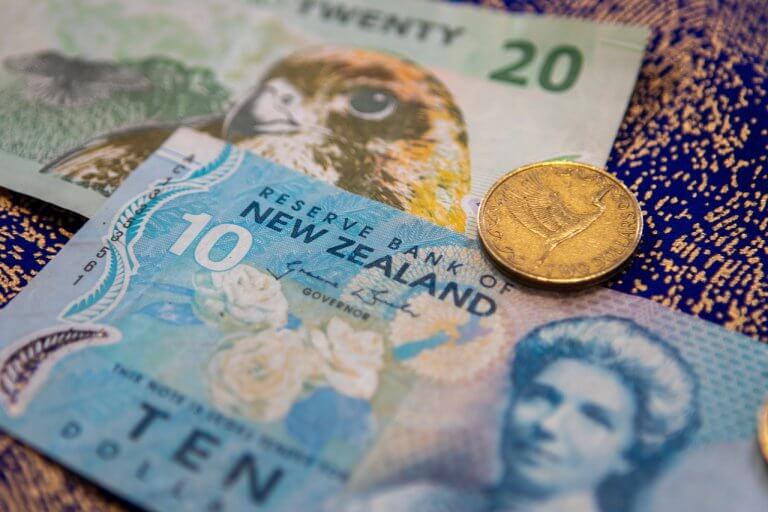
New Zealand is an expensive country as it is quite remote, thereby increasing import costs. Your holiday budget would significantly depend on the season, activities you want to do, kinds of places you’re willing to stay at, having home cooked meals or eating at restaurants, etc.
A rough budget for New Zealand is given below:
Flight
Flight prices would depend on the season and obviously your location, so I am not getting into it here.
Vehicle
| Vehicle Type | High Season | Low Season |
|---|---|---|
| Car (including standard insurance) | NZD 60-150 | NZD 20-70 |
| Campervan | NZD 100-400 | NZD 30-200 |
The price range for camper vans includes vehicles that sleep two people to vehicles that sleep six people.
Fuel
Gas price is about 2 NZD per litre.
Accommodation
| Accommodation Type | High Season | Low Season |
|---|---|---|
| Hostels | NZD 20-45 (avg. 30) | NZD 15-35 (avg.25) |
| Motels & Budget Hotels | NZD 90-250 (avg. 180) | NZD 80-180 (avg. 120) |
| Airbnb | NZD 60-190 (avg. 110) | NZD 45-160 (avg. 85) |
Food
A meal at a sit-in restaurant costs an average of $25 per person if you order one main dish with a glass of wine/ non-alcoholic drink. If you have a bigger appetite, then this may go up to $40 per person.
Activities
Activity prices vary depending on the kind of activity. Examples of popular activities are given below. Prices are per person:
- Kayaking– between 100-250 NZD depending on duration and location
- Hobbiton Tour– 89 NZD
- Maori Performance with Hangi– 100-150 NZD
- Entry to Geothermal Parks– 30-40 NZD
- Whale Watch by Boat– 150 NZD
- Heli Hike– Approx. 500 NZD
- Milford Sound Cruise– 55-100 NZD (Tours from Queenstown/Te Anau will cost more)
- Bungy Jumping– 160 to 275 NZD (AJ Hackett Bungees)
*The above rates are an approximation and subject to change by the respective company
So how much will you spend in total?
| Description | Couple | Group of Friends | Solo |
|---|---|---|---|
| Stay | 100 | 150 | 30 |
| Transport | 80 | 80 | 20 |
| Fuel | 30 | 30 | 0 |
| Food | 70 | 140 | 30 |
| Activties | 50 | 100 | 20 |
| Miscellaneous | 20 | 40 | 10 |
| Total | 350 | 540 | 110 |
| Per Person Budget (Rounded off) | 180 | 140 | 110 |
- If you travel as a couple you will end up spending 180 NZD on an average per person assuming you stay at mid-range hotels/Airbnbs, take an economy car, eat one meal a day at a restaurant, and indulge in a couple of activities except the luxury ones like the heli-hike, scenic heli rides, etc.
- If you travel with your friends in a group of four, you save on stay, transport and fuel as costs get divided amongst all of you. You will end up spending 140 NZD on an average per day, per person.
- If you travel solo, the cost comes down a little and you will end up spending close to 110 NZD on an average per day. You will save on your stay and transportation costs assuming you will be staying at hostels and travel by bus.
During the low season, you can expect the above costs to come down by approximately 30-40%.
For tips on how minimize your budget in New Zealand, read our article Essential Tips to Save Money on a Trip to New Zealand.
Packing Essentials: What to pack for a New Zealand trip?
1. Sunscreen– Carry water-resistant sunscreen with at least SPF 50. The sun in NZ is really strong as sun strength is more in the Southern Hemisphere and also because of the ozone hole above New Zealand. Your skin can get burnt in 15-20 minutes. Click for our favourite face sunscreen and body sunscreen.
Tip: Apply sunscreen on your ears, else you’ll see the skin on your ear peeling off soon enough.
2. Lip Balm with SPF– Oh so important if you don’t want your lips to be flaky and discoloured in a few days of being in New Zealand. Carry a lip balm with SPF 30.
3. Cap/Hat– Ensure to pack a cap/hat to keep the sun off your face. If you have one that covers your ears then it is even better. Also, if you’re travelling in winter, carry a beanie!
4. Sunglasses– Should I even elaborate!
5. Water Bottle– Please bring a bottle. This will accomplish two things- it’ll save you money since tap water is drinkable in New Zealand and it will help you stay environment friendly as you will use less plastic. We love using this collapsible bottle while travelling.
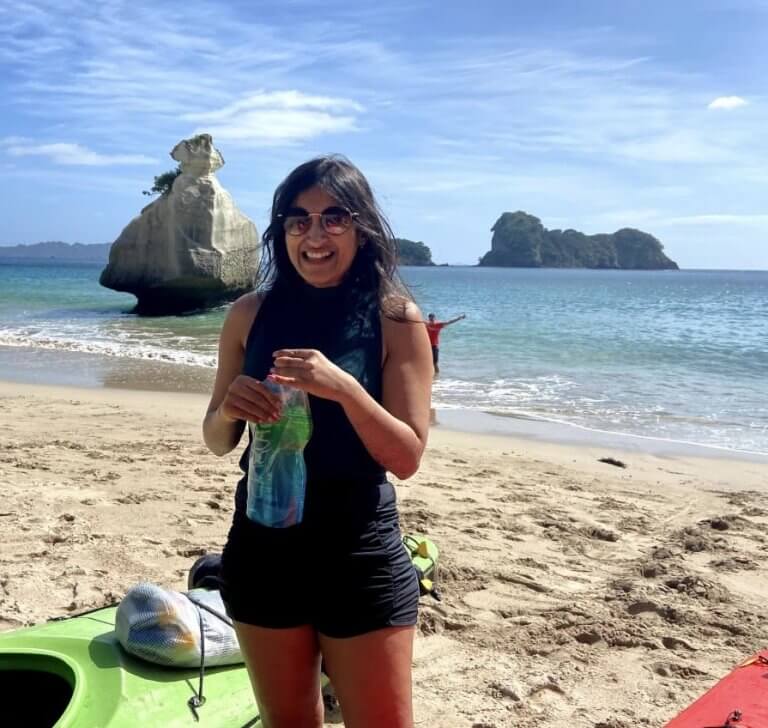
6. Layers for Keeping Warm- The weather in New Zealand is notorious for changing drastically in a matter of minutes. It’ll be sunny one moment and pouring the other. Above all, it is nearly always windy. This makes it essential for you to be prepared when outdoors. Must-haves include:
- A wind cum rain jacket (Umbrellas, unfortunately, struggle to withstand the strong winds here, you might just fly away with your umbrella).
- A down jacket (I used mine all the time even in December),
- A base layer if you’re hiking or visiting the mountains- full sleeve t-shirts work if you don’t feel very cold, but if you’re like me and feel colder than other people, carry a sweater/warmer/fleece as a base layer.
- Multiple base layers if travelling in winter.
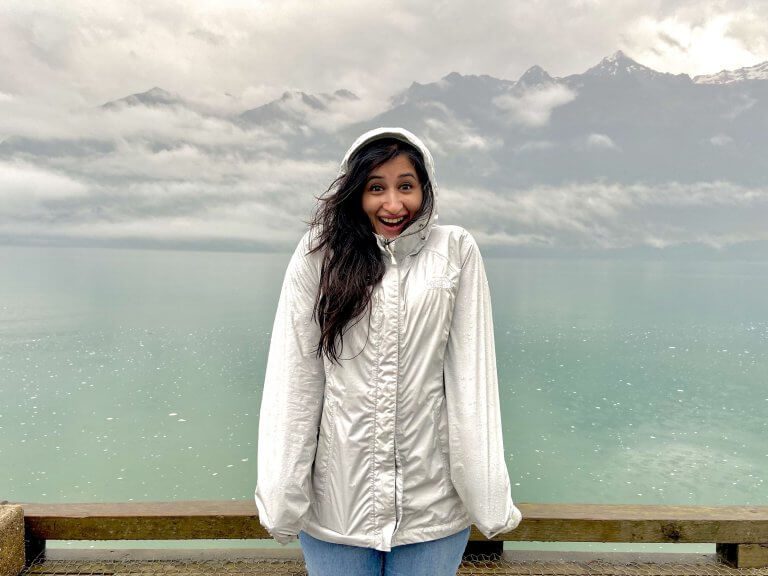
7. Light Comfortable Casual Clothing– Kiwi dress code is casual. Unless you are going to hip restaurants and bars in Auckland/Wellington/Christchurch, you don’t need heels (for her)/formal shoes (for him) or fancy clothes. Actually, you don’t need heels or formal shoes at all. Carry light, comfortable clothing to keep you cool, your bag light, and you relaxed for long days of adventuring.
8. Togs ( Swim Suit/Trunks)– If you are travelling in the summer, chances are that you’ll be in the water plenty. Carry two sets of swimwear so you have a dry one to slip into always. If you’re okay donning a wet swimsuit or travelling in winter then carry one!
9. Hiking Shoes/Sandals– We learnt the importance of hiking shoes on a hike to Tongariro as we didn’t have them. If you’re planning to do any medium to difficult level hikes but have never hiked in anything other than regular sports shoes then trust me and invest in one, your feet will be thanking you.
10. Insect Repellent– Ensure your repellent has DEET to keep the flies away, especially sand flies. New Zealand has good merciless ones.
11. A Travel Pillow– Much needed for the long journey to remote New Zealand. Try the TRTL pillow, it’s comfortable, not bulky, and can easily be wrapped on your bag’s handle. If you can’t get your hands on one, try this instead.
12. Packing cubes– Packing in cubes makes organising and finding clothes on long trips much easier. Plus you can really compress your clothing in them. Check out this helpful video on how to pack like a pro with packing cubes.
13. Driving License– Do not forget your license if you’re going to be driving. If your license is not in English, get it translated by your embassy or by a transport agency in New Zealand or else get an international driving permit.
14. Universal Adapter—Do not forget this if you want to charge your gadgets. New Zealand has Type I sockets with a standard voltage of 230V.
15. Kindle– For long layovers and longer flights! Kindles are the best invention if you’re into reading- thin, lightweight and can hold all the books you would ever want to read. A lot of people say- I want to read a real book. Sure! But carry a kindle for vacations. You will surely be in love with it in a matter of days.

16. Charging Port for the Car– A charging port is a much-needed convenience on a road trip!
17. Phone Stand for the Car– You will need a phone stand since you aren’t allowed to hold your phone while driving and will need google maps for directions.
18. Motion sickness Pills– If you get car sick or seasick, you’ll probably want this on you.
We have made a very detailed packing list that is suitable for all your travels. To have it delivered to your inbox, please fill your details in the box below.
Pack Light
I cannot stress this less- travel light during your New Zealand Trip and preferably with a rucksack if not staying at high-end hotels. Reasons for this are:
- There are plenty of chances your B&B will be on the first floor and you would have to carry your luggage up. Or there will be gravel on the floor hindering the rolling of the wheels of the suitcase. I am not the strongest and suffered carrying my suitcase to rooms in 13 places. Never again am I carrying a suitcase unless I am going to stay at hotels with elevators.
- Also, your B&B/hotel/hostel may have a tiny bedroom making it difficult to move around if you have a lot of luggage.
Tip: If you just have to carry a suitcase and are really troubled with carrying it to your room at each new accommodation then you can try the following hack.
If you’re staying only for a night at the next location, keep your clothes and essentials for the day after that in a handbag so that you can leave your suitcase in the car. You can do this alternately at each location or for shorter stays.
Note: Leave your suitcase in the car only if you have off-street parking and only in the boot. Do not ever leave your luggage overnight on the passenger seat. I have heard and read a ton of stories of thefts and you don’t want to be the next victim. Over and above the trouble you will have to go through, buying new clothes in New Zealand will be very expensive. Please practise this with utter caution. If in any doubt, take your luggage with you to your room.
What not to pack– Do not pack food items like fruits, nuts, vegetables, grains; plants; animal products and outdoor recreational equipment. These classify as a biosecurity risk which will attract a fine of $400 ONLY. Your bags will be x-ray scanned, sniffed by a dog, or /and searched manually. Do you want to take the risk? Yeah…Nah (No, Thank You)! We did not take any food items whatsoever and cleaned our shoes beforehand to be on the safe side.
For a comprehensive list of what you can’t carry read here.
Click to read the super-effective packing tips we follow on our travels.
Resources: What are the helpful apps and websites I may need?
- Skyscanner, MakeMyTrip– For flight bookings.
- Airbnb, Booking.com, HostelWorld, BookABach, BachCare– For accommodation bookings.
- Google Maps, Maps.me – Download the maps for all areas of New Zealand you will be travelling through beforehand. I say travelling through because you should download maps of the entire area between two cities (I practically downloaded the entire map for South and North Island). The connectivity in NZ is patchy and you do not want to be stuck somewhere without directions.
- Uber, Ola, Zoomy– In big cities, you may want to leave your car behind to avoid the hassle of finding parking space.
- ParkMate– This app shows the parking lots in an area and the pricing at that parking lot. The best part about this app is that you don’t have to guess beforehand the number of hours you will be parking your car at a particular spot in order to make the prepayment. You can simply enter your car and card details in the app and the timer will start. When you come back after how much ever time, just stop the timer and you will be charged accordingly.
- CamperMate (for campervans)- Will help you locate campsites near your area. It also mentions the facilities those sites offer along with pricing so you can easily choose where you would like to camp for the night.
- Okay2stay.co.nz (for campervans) – Find places where you can park your self-contained camper overnight with food and wine producers as opposed to staying at camping grounds.
- PriceWatch.co.nz, Gaspy– Tell you which stations around you have the cheapest fuel.
- Lastminute.co.nz, Wotif – For all last minute booking including hotels, car rentals, flights etc.
- Eventfinda– For information on performances, gigs etc.
- Groupon, Treatme, Grabone, Restaurant Hub, First Table– For deals on restaurants.
- Bookme, Groupon, Grabone– For deals on activities.
- Star Chart– For making more sense of NZ’s brilliant starry sky
Other must knows while planning a New Zealand Trip
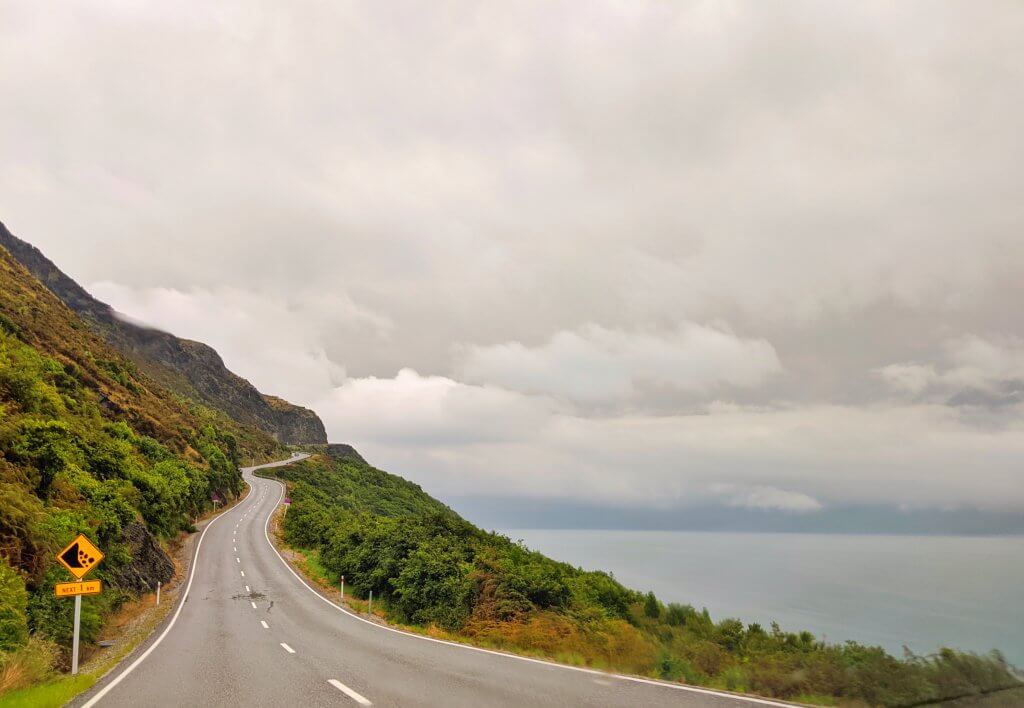
- Sim: Pick a sim card at the airport or when you get to the city- You have options of Spark, Skinny, Vodafone and 2 Degrees. The price difference between operators isn’t that much for travel sims. You can check their websites beforehand. We used Spark and didn’t have any issues.
- I-Site: There are I-Sites or information centres across the country at all tourist locations. You can hop in for information on the area, things to do, bookings etc.
- Emergency Number: The New Zealand Emergency Number is 111. You can call this number even if you do not have any credit/balance left.
- Tax: Taxes are included in the price of things you buy. There is no VAT/GST refund available for tourists.
- Money: Credit/Debit Cards can be used literally everywhere. You need to have very little cash on you- just for emergencies.
- Tipping: Tipping is not required but appreciated for excellent service.
- Accent: The New Zealand accent can be tough to understand sometimes as their vowel pronunciations are different. To understand it better and be used to it beforehand, read here.
- New Zealand Slang: Kiwis have their own words and phrases that are must-knows so you can converse with them easily. Read here.
- Maori Words: Maori words to know before you land in New Zealand:
- Aotearoa (ow-tee-a-row-a)- New Zealand
- Kia Ora ((kee-oh-ruh) – Hello/Cheers/Thank You (It’s the word you will hear the most)
- Haere Mai (hi-ray my)- Welcome
- Morena (mo-reh-nuh)- Good Morning
- Põmarie (Po-mah-ree-ay)-Goodnight
- Ae (eye) – Yes
- Kāore (Kah-o-ray)- No
- Haere rā (high-ray-rah): Goodbye
- Kai (k-eye)- Food
- Moana (mo-aa-na)- Ocean (I always remember this one because of the Disney movie)
I know a ton of information can be daunting but it is important to have in order to plan a perfect New Zealand Trip so you can be aware of the nitty-gritty and make the most of your vacation. Bookmark this article to your browser or pin on Pinterest so you can come back to it even while you’re in there. Let us know what you think of the information, if you found the tips helpful and if any more information should be added!
Haere rā!
This blog post has affiliate links that enable us to earn a small commission when you make a purchase, with no extra cost to you. We only recommend products and activities we like and those that might interest you.

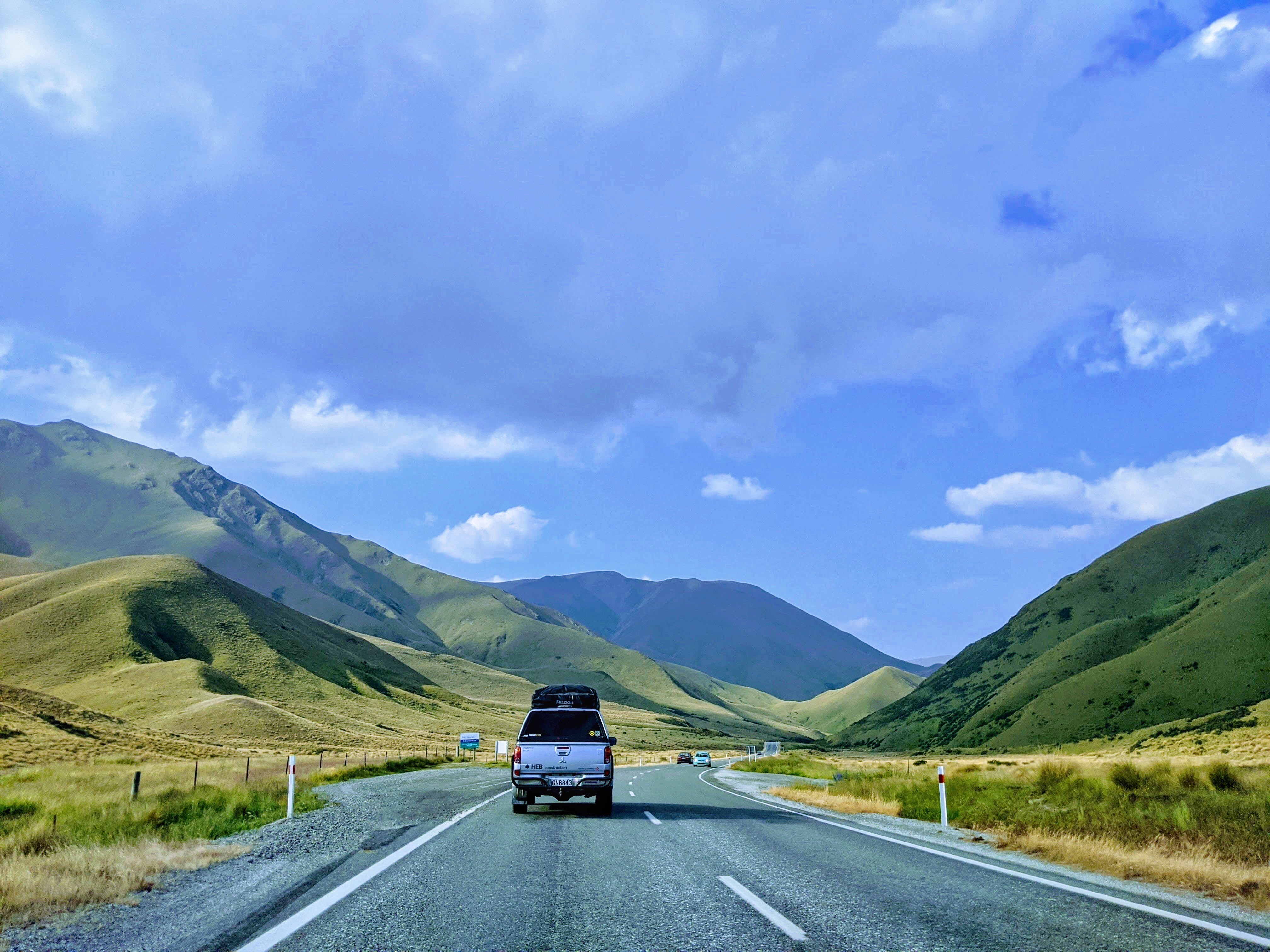
This is a really thorough guide for a vacation in New Zealand. I have this listed on my travel bucket list. Hopefully one day, we can visit. I would really love to just move there. Hmmm.. I wonder what their criteria is for immigrant application. It would be nice to live there and enjoy all the natural beauty around.
You should totally visit. Living there would be cherry on the cake. We stayed at an Airbnb (farmhouse) whose owners were immigrants and they seemed so content living there. We ourselves have discussed moving there many times though we haven’t done research on the immigrant app criteria. I guess its a distant dream for us.
The perfect guide to go to New Zeland. I have never been there. The more I read your blog, the more I realize that there so many places I don’t know yet. Thank you for making me travel.
Thanks, Charlotte. Glad we inspired you to visit and made you travel virtually.
This is an awesome guide on how to plan a perfect trip to New Zealand. I love how you broke down each aspect of travel in this remote Island of Oceana. Personally, I agree that if we go all the way down there from the States, then we are going to need at least 3 weeks if not a full month! But at roughly $75 – $120 USD a person a day, I may have to figure out a way to cut some costs or win the lotto cause that sounds a bit pricey!
Perhaps, I will have to do the hop on Hop off type busses and trains rather than the iconic Campervan. Though with the costs of place to stay and transport, I am not sure I wont be breaking even. But I will have to plan it all out with your info better!
Hi Eric. New Zealand is really pricey. However, the prices given in the article are in New Zealand Dollar and the total budget is given for high season. Assuming you’re travelling solo it would cost you about 110 NZD (approx 75 USD) in high season. To save money and yet make the most of your time in NZ, it would be best to travel in the shoulder or low season, cook your own food and spend less on paid activities and more time hiking. Your per day expenses could fall by half in such a case and you won’t really need to win the lotto. 🙂 You could also refer to our blog post on how to save money in NZ—https://trywanderingmore.com/essential-tips-to-save-money-on-a-trip-to-new-zealand/ … Hope this helps 🙂
Wow this is really informative! So much info on travelling to NZ! We won’t be travelling anywhere soon but NZ is on my bucket list!
It sucks that travel has come to a standstill but I’m glad to hear that NZ is on your bucket list. This info will be helpful whenever you do travel there!
Australia is the furthest south I’ve been and NZ would be another hike to visit! I do love the landscape and the fact that it is so small, it isn’t crowded at all. Just a country to really chill and slow travel in.
Slow travel would have been amazing here. Though because it’s so pricey we did quite a fast-paced 18-day trip to cover most places.
wow! looks so dreamy! I would so travel there and enjoy it as much as I can
Thanks for this comprehensive and informative article on planning a New Zealand trip. Would love to visit here someday.
This post is really helpful for us we were planning to visit NZ but because of covid plans got canceled. Will refer this again when traveling.
Oh! Such a bummer. We hope you have an amazing trip when you do travel there.
These are great tips!! I have never been to New Zealand but heard a lot of about it. Thanks for sharing the tips…. Quite helpful